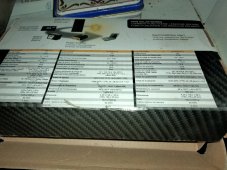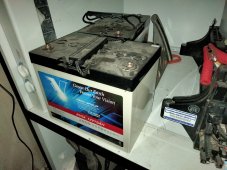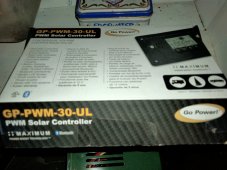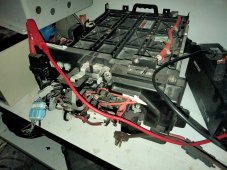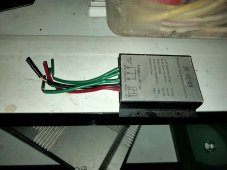schaanman
New Member
- Joined
- Jul 14, 2022
- Messages
- 9
I am very much a beginner and have been purchasing equipment as I find good deals without really knowing what I was doing. Is there any way I can make these work together? I only want to power a freezer and a fan, light and charge cell phones, etc. I started researching and am afraid my invertor is too big and not sure how to tie in a 400W wind generator with my 700 watts of panels. the invertor is 12 or 24 though 12 would be easies?. or tell me where to start looking for correct info. I would usually spend more time learning but I think I might need this soon. sorry, I'm not more informed or prepared. thank you
Go Power Charge controller PWM 30-UL mppt 30A
1st generation honda insight lithium
2 Generac PWRCELL 11/2021 https://www.ecodirect.com/Generac-PWRcell-Mod3-38kWh-Battery-Module-Li-Ion-p/generac-a0000391219.htm
JC 12/24 wind generator controller
5000w LF
Split phase
Pure Sine Wave Power Inverter
with
20A battery charger function
https://vi.raptor.ebaydesc.com/ws/e...369803164&cspheader=1&versionid=3368618211026
AC 110V: 2500W continue power, 10000w peak power
AC220V:2500W continue power, 10000w peak power
DC 12V to AC 110V & 220v
AMG VERSION
OPTION A(factory setting):
110v max output: 2500w
JUMP CABLE OPERATION:
2PCS jumper cable required,
1+3 & 2+4
no 220v service
output operation:
L1+N1 OR L2+N2=110V MAX OUTPUT
OPTION B:
1250W 110V OR 2500W 220V
JUMP CABLE OPERATION:
1PC jumper cable required,
2+3
output operation:
110V :
MAX 1250W
L1+N1 OR L2+N2
220V :
MAX 2500W
L1+L2
Seller's command for AMG versions:
What is the AMG version means?
Idea is come from Benz amg version, they use same engineer like 2.0 cc from 200HP become 400HP, then you
don't have buy big car to have 400HP, also in the normal time you can save your gas oil, if you want mass power
the AMG car will be ready any time for you!
Now Power Jack use same idea to offer more power & handy version for you.
The last 5 years before, we offer SP version, we have 2 sets output from the transformer, if customer need 110v output, then they can choice one of them to get it, if need 220v, we in series to offer 220v. But this way 110v only 50% power, that's a big wasting.
Now the whole new design is we put jumper cable outside, if you need full 110v power, then you can in parallel buy yourself, but this moment no 220v service.
If you want using 220v, then you have to in series 2 sets
110v by yourself through the jumper cable.
Also the same coil we put more wires on the transformer about 1.5 times than before, now they become more powerful, the temperature can keep under 80C.
The original long is 60cm, now just 40cm, we save the cost offer same power for our customer.
Now the marketing for 3000w High Frequency only 5-6kgs, but not good for heaving loading, usually 2-3 months dead, the cost around US$350, but they only offer 110v, no 220v to using it.
Now power jack offer you under US$300 but you have 110v & 220v for choice, all is assemble model, if mosfet dead, you are using to repair yourself, but HF inverter dead, you just throw it away.
The first trial stocks only 40pcs, after sold out, the sell price will become USD349.99, the shipment is on the way, all you need is just wait for 5 weeks more, so let keep the chance try our AMG versions, thank you!
Seller's command:
1.Ideally suitable for Journeys, Camping, Tents, Boat Trip, Working on the way and everywhere, where is no electricity !
Simply connect our with a 12v Battery.For example as in a Car, Motorcycle, Camper or Boat and use 110v or 220V electrical appliances.
2.Possible Uses:Equipment,Entertainment Electronics,Household Appliances,Kitchen Devices,Electrical Tools
3.This item is mainly design for more heavy load,such as motor machine,and when it works with your appliance,you should connect with a battery bank and the AC side need to connect with your home source first.
4.This item will with the universal sockets on the AC output side, it can be used in your country.
What's the different between high frequency and low frequency?
High frequency power inverter have limit for running appliances with motors, engines, special light and TV
Low frequency power inverter available for sensitive load, accept generator's energy output, high power factor, and follow our warning label, it would not have any problems.
the output sockets are universal sockets, available for any country.
Feature:
Ideally suitable for Journeys, Camping, Tents, Boat Trip, Working on the way and everywhere, where is no electricity!
Simply connect our with 12V battery.
For example as in a Car, Motorcycle, Camper or Boat and use 110V &220V electrical appliances.
Possible Uses:
Equipment:
Computer, Laptop, Monitors, Fax Devices, Scanner
Entertainment Electronics:
TV, DVD-Player, Play Consoles, Hi-Fi-Systems, Music Instruments, Satellite Decoder
Household Appliances:
Fans, Electric Shaver, etc.
Kitchen Devices:
Toaster etc.
Electrical Tools:
Drill, etc.
Specification :
Free repair,buyer pay for return postage and resend postage.Or we can send parts for repair , buyer responsible for the postage
Go Power Charge controller PWM 30-UL mppt 30A
1st generation honda insight lithium
2 Generac PWRCELL 11/2021 https://www.ecodirect.com/Generac-PWRcell-Mod3-38kWh-Battery-Module-Li-Ion-p/generac-a0000391219.htm
JC 12/24 wind generator controller
5000w LF
Split phase
Pure Sine Wave Power Inverter
with
20A battery charger function
https://vi.raptor.ebaydesc.com/ws/e...369803164&cspheader=1&versionid=3368618211026
AC 110V: 2500W continue power, 10000w peak power
AC220V:2500W continue power, 10000w peak power
DC 12V to AC 110V & 220v
AMG VERSION
OPTION A(factory setting):
110v max output: 2500w
JUMP CABLE OPERATION:
2PCS jumper cable required,
1+3 & 2+4
no 220v service
output operation:
L1+N1 OR L2+N2=110V MAX OUTPUT
OPTION B:
1250W 110V OR 2500W 220V
JUMP CABLE OPERATION:
1PC jumper cable required,
2+3
output operation:
110V :
MAX 1250W
L1+N1 OR L2+N2
220V :
MAX 2500W
L1+L2
Seller's command for AMG versions:
What is the AMG version means?
Idea is come from Benz amg version, they use same engineer like 2.0 cc from 200HP become 400HP, then you
don't have buy big car to have 400HP, also in the normal time you can save your gas oil, if you want mass power
the AMG car will be ready any time for you!
Now Power Jack use same idea to offer more power & handy version for you.
The last 5 years before, we offer SP version, we have 2 sets output from the transformer, if customer need 110v output, then they can choice one of them to get it, if need 220v, we in series to offer 220v. But this way 110v only 50% power, that's a big wasting.
Now the whole new design is we put jumper cable outside, if you need full 110v power, then you can in parallel buy yourself, but this moment no 220v service.
If you want using 220v, then you have to in series 2 sets
110v by yourself through the jumper cable.
Also the same coil we put more wires on the transformer about 1.5 times than before, now they become more powerful, the temperature can keep under 80C.
The original long is 60cm, now just 40cm, we save the cost offer same power for our customer.
Now the marketing for 3000w High Frequency only 5-6kgs, but not good for heaving loading, usually 2-3 months dead, the cost around US$350, but they only offer 110v, no 220v to using it.
Now power jack offer you under US$300 but you have 110v & 220v for choice, all is assemble model, if mosfet dead, you are using to repair yourself, but HF inverter dead, you just throw it away.
The first trial stocks only 40pcs, after sold out, the sell price will become USD349.99, the shipment is on the way, all you need is just wait for 5 weeks more, so let keep the chance try our AMG versions, thank you!
Seller's command:
1.Ideally suitable for Journeys, Camping, Tents, Boat Trip, Working on the way and everywhere, where is no electricity !
Simply connect our with a 12v Battery.For example as in a Car, Motorcycle, Camper or Boat and use 110v or 220V electrical appliances.
2.Possible Uses:Equipment,Entertainment Electronics,Household Appliances,Kitchen Devices,Electrical Tools
3.This item is mainly design for more heavy load,such as motor machine,and when it works with your appliance,you should connect with a battery bank and the AC side need to connect with your home source first.
4.This item will with the universal sockets on the AC output side, it can be used in your country.
What's the different between high frequency and low frequency?
High frequency power inverter have limit for running appliances with motors, engines, special light and TV
Low frequency power inverter available for sensitive load, accept generator's energy output, high power factor, and follow our warning label, it would not have any problems.
the output sockets are universal sockets, available for any country.
Feature:
Ideally suitable for Journeys, Camping, Tents, Boat Trip, Working on the way and everywhere, where is no electricity!
Simply connect our with 12V battery.
For example as in a Car, Motorcycle, Camper or Boat and use 110V &220V electrical appliances.
Possible Uses:
Equipment:
Computer, Laptop, Monitors, Fax Devices, Scanner
Entertainment Electronics:
TV, DVD-Player, Play Consoles, Hi-Fi-Systems, Music Instruments, Satellite Decoder
Household Appliances:
Fans, Electric Shaver, etc.
Kitchen Devices:
Toaster etc.
Electrical Tools:
Drill, etc.
Specification :
| Brand | Power Jack |
| Item no. | LF-SP-PSW-5000-12-110/220 |
| Continuous Output Power | 2500W |
| Max Output Power | 10000W |
| DC Input Voltage | 12V |
| AC Output Voltage | 110V/220V |
| Regulation | ±5% |
| Frequency | 60HZ±3% |
| Efficiency | 90% |
| Output Wave Form | Pure Sine Wave |
| Temperature Protection | 70C |
| Input Low Voltage Alarm | 10.5V |
| Input Low Voltage shutdown | 10V |
| Input High Voltage Alarm | 14.5V |
| Input High Voltage shutdown | >15V |
| Dimension | 400*290*240MM |
| Warranty | 1 year |
| Weight | 14Kgs |
| Certificate | CE |
| Components | Made in CHINA |
| Design | Taiwan |
Free repair,buyer pay for return postage and resend postage.Or we can send parts for repair , buyer responsible for the postage
Attachments
Last edited:



